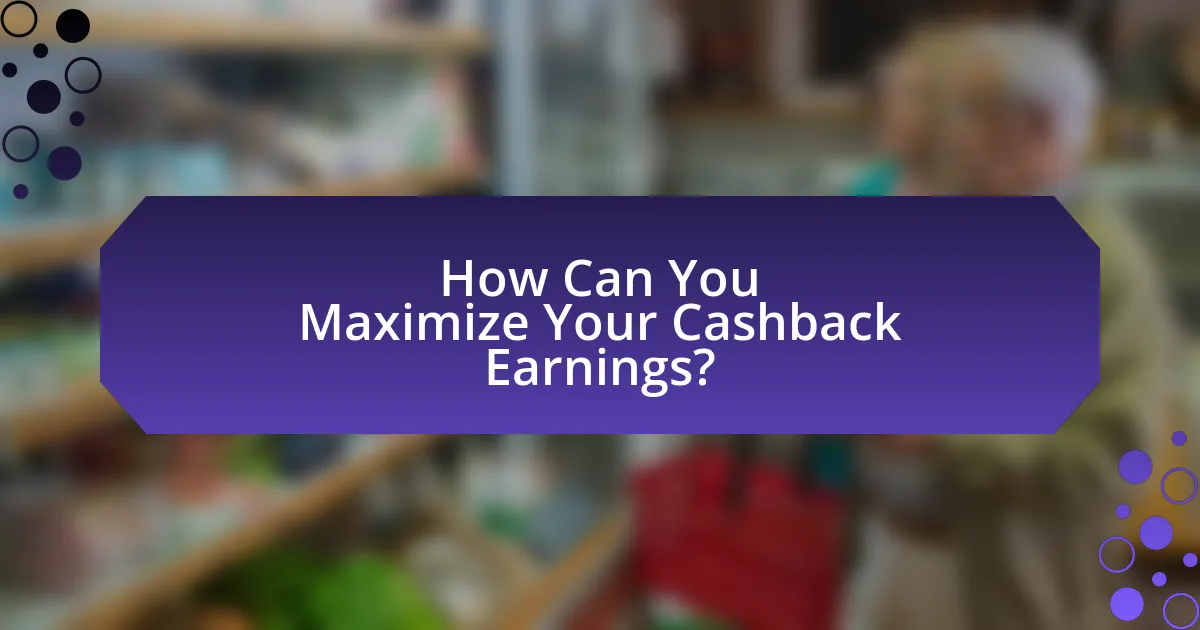The article focuses on the best credit cards for earning cashback on everyday purchases, highlighting options such as the Chase Freedom Flex, Citi Double Cash Card, and Discover it Cash Back card. It explains how cashback credit cards function, detailing the typical cashback percentages, qualifying purchases, and potential limits on earnings. Additionally, the article discusses key features to consider when selecting a cashback card, including annual fees, redemption options, and sign-up bonuses. Strategies for maximizing cashback earnings and common pitfalls to avoid are also addressed, providing readers with a comprehensive understanding of how to effectively utilize cashback credit cards.

What are the Best Credit Cards for Earning Cashback on Everyday Purchases?
The best credit cards for earning cashback on everyday purchases include the Chase Freedom Flex, which offers 5% cashback on rotating categories and 1% on all other purchases, and the Citi Double Cash Card, providing 2% cashback on all purchases (1% when you buy and 1% when you pay). Additionally, the Discover it Cash Back card offers 5% cashback on rotating categories and 1% on other purchases, while the Blue Cash Preferred Card from American Express gives 6% cashback on groceries and 3% on gas. These cards are recognized for their competitive cashback rates and flexibility in earning rewards on common spending categories.
How do cashback credit cards work?
Cashback credit cards reward users with a percentage of their spending back as cash. When a cardholder makes a purchase, a predetermined percentage of that transaction is credited back to their account, typically ranging from 1% to 5%, depending on the card and the category of the purchase. For example, a card may offer 1.5% cashback on all purchases, while specific categories like groceries or gas may yield higher rates, such as 3% or 5%. Cardholders can usually redeem their cashback as a statement credit, direct deposit, or gift cards. According to a 2022 report by the Consumer Financial Protection Bureau, cashback rewards are a popular incentive, with many consumers choosing cards based on the potential for earning rewards on everyday expenses.
What is the cashback percentage typically offered?
The cashback percentage typically offered by credit cards ranges from 1% to 5%. Many credit cards provide a standard cashback rate of 1% on all purchases, while specific categories such as groceries, gas, or dining may offer higher rates, often around 3% to 5%. For example, cards like the Chase Freedom Flex offer 5% cashback on rotating categories each quarter, demonstrating the variability in cashback percentages based on spending categories.
Are there any limits on cashback earnings?
Yes, there are limits on cashback earnings. Many credit cards impose caps on the amount of cashback that can be earned within a specific time frame, such as monthly or annually. For example, some cards may limit cashback to a maximum of $300 per year or restrict higher cashback rates to a certain spending threshold, like $1,500 in eligible purchases per quarter. These limits are designed to manage the financial exposure of the credit card issuer while still providing rewards to consumers.
What types of purchases qualify for cashback?
Purchases that qualify for cashback typically include everyday expenses such as groceries, gas, dining, and online shopping. Many credit cards offer cashback rewards on these categories, often providing higher percentages for specific spending types. For instance, a study by the Consumer Financial Protection Bureau indicates that consumers can earn between 1% to 5% cashback on these common purchases, depending on the credit card’s terms and conditions.
Which categories offer the highest cashback rates?
Categories that offer the highest cashback rates typically include groceries, dining, and gas. For instance, many credit cards provide up to 6% cashback on grocery purchases, 3% on dining, and 2% on gas. These rates are often part of promotional offers or specific rewards programs designed to incentivize spending in these essential areas.
Do different cards have varying eligibility for cashback categories?
Yes, different cards have varying eligibility for cashback categories. Each credit card issuer designs its cashback program with specific categories that may include groceries, gas, dining, or online shopping, and these categories can differ significantly between cards. For example, some cards may offer higher cashback rates for certain categories during promotional periods, while others may provide a flat rate across all purchases. This variability is evident in cards like the Chase Freedom Flex, which offers rotating categories each quarter, compared to the flat-rate cashback offered by cards like the Citi Double Cash.
What are the key features to consider when choosing a cashback card?
When choosing a cashback card, key features to consider include the cashback rate, redemption options, annual fees, and bonus categories. The cashback rate determines how much you earn on purchases, with some cards offering higher rates for specific categories like groceries or gas. Redemption options refer to how you can use your cashback, whether as statement credits, gift cards, or direct deposits. Annual fees can impact the overall value of the card, as a high fee may outweigh the benefits if cashback earnings are low. Lastly, bonus categories allow cardholders to earn extra cashback in specific spending areas, enhancing the card’s value based on individual spending habits.
How do annual fees impact the overall value of a cashback card?
Annual fees can significantly reduce the overall value of a cashback card by offsetting the rewards earned. For instance, if a cashback card offers 1.5% back on purchases but charges a $100 annual fee, a cardholder would need to spend approximately $6,667 annually just to break even on the fee. This calculation demonstrates that unless spending is high enough to surpass the annual fee, the card may not provide a net benefit. Additionally, many cashback cards without annual fees can offer competitive rewards, making them more appealing for consumers who want to maximize value without incurring extra costs.
What role do sign-up bonuses play in cashback credit cards?
Sign-up bonuses serve as an incentive for consumers to choose cashback credit cards over others. These bonuses typically offer a substantial amount of cashback or points after meeting a specified spending threshold within a certain timeframe, which can significantly enhance the card’s overall value. For instance, a card may offer a $200 cashback bonus after spending $1,000 in the first three months, making it appealing for new users looking to maximize their rewards. This strategy not only attracts new customers but also encourages higher initial spending, thereby increasing the card issuer’s revenue through transaction fees.

What are the Top Cashback Credit Cards Available Today?
The top cashback credit cards available today include the Chase Freedom Flex, which offers 5% cashback on rotating categories and 1% on all other purchases, and the Citi Double Cash Card, providing 2% cashback on all purchases (1% when you buy and 1% when you pay). Additionally, the Discover it Cash Back card features 5% cashback on rotating categories and 1% on all other purchases, while the Capital One Quicksilver Cash Rewards Credit Card offers a flat 1.5% cashback on every purchase. These cards are recognized for their competitive cashback rates and flexible redemption options, making them ideal for everyday spending.
Which credit cards offer the best cashback rates for groceries?
The credit cards that offer the best cashback rates for groceries include the Blue Cash Preferred Card from American Express, which provides 6% cashback on groceries at U.S. supermarkets up to $6,000 per year, and the Chase Freedom Flex, which offers 5% cashback on grocery purchases during specific quarterly promotions. Additionally, the Citi Double Cash Card allows for 2% cashback on all purchases, including groceries, with no limit. These cards are recognized for their high cashback rates, making them ideal for grocery shopping.
What specific cards are recommended for grocery shopping?
The specific cards recommended for grocery shopping include the American Express Blue Cash Preferred Card, which offers 6% cashback on groceries at U.S. supermarkets, and the Chase Freedom Flex, providing 5% cashback on grocery purchases during specific quarterly promotions. Additionally, the Capital One SavorOne Cash Rewards Credit Card gives 3% cashback on dining and grocery purchases. These cards are validated by their cashback structures, which are designed to maximize rewards on everyday grocery spending.
How do these cards compare in terms of rewards and fees?
The comparison of these cards in terms of rewards and fees reveals that some cards offer higher cashback percentages on specific categories, while others may have lower annual fees or no fees at all. For instance, a card may provide 5% cashback on groceries but charge a $95 annual fee, whereas another card might offer 1.5% on all purchases with no annual fee. This indicates that the best choice depends on individual spending habits and preferences, as higher rewards can be offset by higher fees.
What credit cards are ideal for online shopping cashback?
The ideal credit cards for online shopping cashback include the Chase Freedom Unlimited, which offers 1.5% cashback on all purchases, and the Citi Double Cash Card, providing 2% cashback on all purchases (1% when you buy and 1% when you pay). Additionally, the Discover it Cash Back card features rotating categories that can earn 5% cashback on specific online shopping categories each quarter, up to a quarterly maximum. These cards are recognized for their competitive cashback rates and flexibility, making them suitable for frequent online shoppers.
Which platforms or retailers are partnered with these cards?
The platforms and retailers partnered with cashback credit cards typically include major grocery chains, online retailers, and gas stations. For example, cards like the Chase Freedom Flex offer cashback at retailers such as Amazon, Walmart, and grocery stores, while the Discover it Cash Back card provides enhanced cashback at rotating categories that often include restaurants and gas stations. These partnerships allow cardholders to maximize their rewards on everyday purchases, as evidenced by the specific cashback offers tied to these retailers.
What additional benefits do these cards provide for online shoppers?
These cards provide additional benefits for online shoppers, including enhanced security features, rewards programs, and purchase protection. Enhanced security features, such as virtual card numbers and fraud monitoring, help protect against unauthorized transactions. Rewards programs often offer cashback or points for online purchases, incentivizing spending. Purchase protection covers eligible items against damage or theft for a specified period, providing peace of mind for consumers. These benefits collectively enhance the online shopping experience by ensuring safety, rewarding spending, and protecting purchases.
How do travel-related purchases earn cashback?
Travel-related purchases earn cashback primarily through credit cards that offer specific rewards programs. These credit cards typically provide a percentage of the purchase amount back to the cardholder when they book flights, hotels, or other travel expenses. For example, many travel credit cards offer 1.5% to 5% cashback on travel-related transactions, incentivizing users to utilize their cards for these purchases. This cashback is often credited to the cardholder’s account as a statement credit or can be redeemed for travel rewards, further enhancing the value of the cashback earned.
Which cards offer enhanced cashback for travel expenses?
Cards that offer enhanced cashback for travel expenses include the Chase Sapphire Preferred Card, which provides 2x points on travel and dining, and the Capital One Venture Rewards Credit Card, offering 2x miles on every purchase, including travel. Additionally, the American Express Gold Card gives 3x points on restaurants and 3x points on flights booked directly with airlines. These cards are designed to maximize rewards for travel-related spending, making them ideal for frequent travelers.
Are there any restrictions on travel-related cashback earnings?
Yes, there are restrictions on travel-related cashback earnings. Many credit cards impose limits on the amount of cashback that can be earned on travel purchases, often capping the percentage at a certain threshold or limiting the total cashback amount per year. For example, some cards may offer a higher cashback rate for travel purchases but only up to a specific spending limit, after which the rate decreases. Additionally, certain categories of travel expenses, such as airline tickets or hotel bookings, may qualify for cashback while others, like travel insurance or taxes, may not.

How Can You Maximize Your Cashback Earnings?
To maximize your cashback earnings, utilize credit cards that offer higher cashback rates on categories where you spend the most, such as groceries, gas, or dining. Research shows that some credit cards provide up to 5% cashback in specific categories, significantly increasing potential earnings. Additionally, take advantage of promotional offers and sign-up bonuses, which can add substantial cashback in the first few months of account opening. Regularly review your spending habits and adjust your card usage to align with the highest cashback opportunities available.
What strategies can you use to earn more cashback?
To earn more cashback, utilize credit cards that offer higher rewards rates on specific categories such as groceries, gas, or dining. Many credit cards provide bonus cashback for purchases in these categories, often ranging from 3% to 5%. Additionally, take advantage of promotional offers and sign-up bonuses that can significantly boost your cashback earnings in the initial months after opening an account.
Using cashback apps and websites can further enhance your earnings by providing additional cashback on purchases made through their platforms. For instance, some apps offer up to 10% cashback at select retailers. Lastly, consistently pay off your balance in full to avoid interest charges, which can negate the benefits of cashback rewards.
How can you effectively track your spending to maximize rewards?
To effectively track your spending and maximize rewards, utilize budgeting apps or spreadsheets that categorize expenses and link to your credit card accounts. These tools provide real-time insights into spending patterns, allowing you to identify which categories earn the most cashback or rewards points. For instance, according to a 2021 survey by CreditCards.com, 70% of cashback cardholders reported using tracking tools to optimize their rewards. By regularly reviewing your spending data, you can adjust your purchasing habits to align with the highest reward categories offered by your credit card, ensuring you earn the maximum benefits from your everyday purchases.
What role do cashback calendars play in maximizing earnings?
Cashback calendars play a crucial role in maximizing earnings by providing consumers with a structured overview of when specific retailers offer enhanced cashback rates. These calendars allow users to strategically plan their purchases around promotional periods, ensuring they take full advantage of higher cashback percentages. For instance, if a cashback calendar indicates that a particular retailer is offering 5% cashback during a specific week, consumers can time their purchases accordingly, significantly increasing their overall cashback earnings. This strategic approach to spending, informed by cashback calendars, can lead to substantial savings over time, as consumers are more likely to earn higher rewards by aligning their shopping habits with promotional offers.
What are common pitfalls to avoid with cashback credit cards?
Common pitfalls to avoid with cashback credit cards include failing to pay off the balance in full each month, which incurs interest that can negate cashback rewards. Additionally, not understanding the card’s reward structure can lead to missed opportunities for maximizing earnings, as many cards offer higher percentages for specific categories. Another pitfall is overlooking annual fees; some cards may charge fees that exceed the cashback earned. Lastly, neglecting to track expiration dates for rewards can result in losing accumulated cashback. These factors can significantly diminish the benefits of using cashback credit cards.
How can overspending negate the benefits of cashback rewards?
Overspending can negate the benefits of cashback rewards by leading to higher overall expenses that outweigh the cashback earned. For instance, if a consumer spends $1,000 to earn a 2% cashback reward, they receive $20. However, if that spending results in incurring debt with interest rates averaging around 15% annually, the cost of carrying that debt can far exceed the cashback benefit. Therefore, the financial advantage of cashback rewards diminishes when overspending leads to increased debt and interest payments, ultimately resulting in a net loss rather than a gain.
What should you watch out for regarding card fees and interest rates?
When considering credit cards, you should watch out for annual fees, late payment fees, and high-interest rates. Annual fees can significantly reduce the value of cashback earned, especially if the card does not offer substantial rewards. Late payment fees can add up quickly, and high-interest rates can negate any benefits from cashback if balances are not paid in full. For instance, the average credit card interest rate in the U.S. was around 16% as of 2023, meaning carrying a balance can lead to substantial costs. Therefore, it is crucial to evaluate these fees and rates to ensure that the card aligns with your financial habits and goals.
What tips can help you choose the right cashback card for your lifestyle?
To choose the right cashback card for your lifestyle, assess your spending habits and select a card that offers higher rewards in categories where you spend the most, such as groceries, gas, or dining. For example, if you frequently dine out, a card that provides 3% cashback on restaurant purchases will maximize your rewards. Additionally, consider the card’s annual fee versus the potential cashback earnings; a card with a fee may not be worth it if your spending does not justify the cost. Research shows that consumers can earn an average of 1.5% to 5% cashback depending on their spending categories, making it crucial to align the card’s benefits with your financial behavior.



